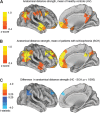The anatomical distance of functional connections predicts brain network topology in health and schizophrenia
- PMID: 22275481
- PMCID: PMC3513955
- DOI: 10.1093/cercor/bhr388
The anatomical distance of functional connections predicts brain network topology in health and schizophrenia
Abstract
The human brain is a topologically complex network embedded in anatomical space. Here, we systematically explored relationships between functional connectivity, complex network topology, and anatomical (Euclidean) distance between connected brain regions, in the resting-state functional magnetic resonance imaging brain networks of 20 healthy volunteers and 19 patients with childhood-onset schizophrenia (COS). Normal between-subject differences in average distance of connected edges in brain graphs were strongly associated with variation in topological properties of functional networks. In addition, a club or subset of connector hubs was identified, in lateral temporal, parietal, dorsal prefrontal, and medial prefrontal/cingulate cortical regions. In COS, there was reduced strength of functional connectivity over short distances especially, and therefore, global mean connection distance of thresholded graphs was significantly greater than normal. As predicted from relationships between spatial and topological properties of normal networks, this disorder-related proportional increase in connection distance was associated with reduced clustering and modularity and increased global efficiency of COS networks. Between-group differences in connection distance were localized specifically to connector hubs of multimodal association cortex. In relation to the neurodevelopmental pathogenesis of schizophrenia, we argue that the data are consistent with the interpretation that spatial and topological disturbances of functional network organization could arise from excessive "pruning" of short-distance functional connections in schizophrenia.
Figures




References
-
- Barthélemy M. 2011 Physics Reports 499:1–101.
Publication types
MeSH terms
Grants and funding
LinkOut - more resources
Full Text Sources
Other Literature Sources
Medical
Research Materials

